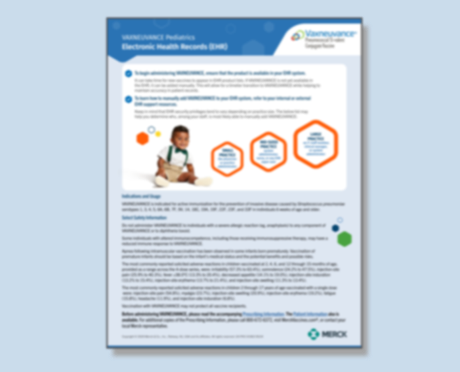
Billing and CPT coding for VAXNEUVANCE
Overview of CPT codes
CPT code for VAXNEUVANCE1 : 90671
Below are lists of additional codes that may be relevant for VAXNEUVANCE and its administration. The information provided here is compiled from sources believed to be accurate, but Merck makes no representation that it is accurate.
This information is subject to change. You are solely responsible for determining appropriate codes and for any action you take in billing. The information provided here is not intended to be definitive or exhaustive and is not intended to replace the guidance of a qualified professional advisor. Merck and its agents make no warranties or guarantees, expressed or implied, concerning the accuracy or appropriateness of this information for your particular use given the frequent changes in public and private payer billing.
Plan coding requirements may vary, so it is important to check with each plan as to plan-specific requirements. For claim submission procedures regarding government programs (for example, Medicaid), contact the appropriate program representative.
The use of this information does not guarantee payment or that any payment received will cover your costs. Diagnosis codes should be selected only by a health care professional.
Common billing codes related to VAXNEUVANCE
These commonly-used codes may apply to private payer reimbursement claims.
CPT codes for vaccine administration2
90460: Immunization administration (IA) through 18 years of age via any route of administration, with counseling by physician or other qualified health care professional; first or only component of each vaccine or toxoid administered.
+90461: Each additional vaccine or toxoid component administered (List separately in addition to code for primary procedure) (Use 90460 for each vaccine administered. For vaccines with multiple components [combination vaccines], report 90460 in conjunction with 90461 for each additional component in a given vaccine)
(Do not report 90460, 90461 in conjunction with 91304, 91318-91322, unless both a severe acute respiratory syndrome coronavirus 2 [SARS-CoV-2] [coronavirus disease {COVID-19}] vaccine/toxoid product and at least one vaccine/toxoid product from 90476-90759 are administered at the same encounter)
90471: IA (includes percutaneous, intradermal, subcutaneous, or intramuscular injections); one vaccine (single or combination vaccine/toxoid) (Do not report 90471 in conjunction with 90473)
+90472: Each additional vaccine (single or combination vaccine/toxoid) (List separately in addition to code for primary procedure) (Use 90472 in conjunction with 90460, 90471, or 90473)
(Do not report 90471, 90472 in conjunction with 91304, 91318-91322, unless both a severe acute respiratory syndrome coronavirus 2 [SARS-CoV-2] [coronavirus disease {COVID-19}] vaccine/toxoid product and at least one vaccine/toxoid product from 90476-90759 are administered at the same encounter)
Remember, plan coding requirements vary.
Plan coding requirements may vary, so it is important to check with each plan as to plan-specific requirements. For claim submission procedures regarding government programs (eg, Medicaid), contact the appropriate program representative.
You are solely responsible for determining the appropriate codes and for any action you take in billing. The information provided here is not intended to be definitive or exhaustive, and is not intended to replace the guidance of a qualified professional advisor. Merck makes no warranties or guarantees, expressed or implied, concerning the accuracy or appropriateness of this information for your particular use given the frequent changes in public and private payer billing. The use of this information does not guarantee payment or that any payment received will cover your costs. Diagnosis codes should be selected only by a health care professional.
CPT is a registered trademark of the American Medical Association.
COVID-19, coronavirus disease; CPT, Current Procedural Terminology; EHR, electronic health record; IA, immunization administration. SARS-CoV-2, severe acute respiratory syndrome coronavirus 2.

How to add VAXNEUVANCE to your EHR system
See dosing & administration for VAXNEUVANCE
Review CDC, AAP, and AAFP recommendations
Discover resources for your practice and patients
Read FAQ about VAXNEUVANCE
References
- Immunization Information Systems (IIS): CPT codes mapped to CVX codes. Centers for Disease Control and Prevention. Last reviewed October 24, 2024. Accessed October 29, 2024. https://www2a.cdc.gov/vaccines/iis/iisstandards/vaccines.asp?rpt=cpt
- American Medical Association (AMA). CPT Category I New Vaccine Codes (Including Incorporation of ACIP Abbreviations Listing) Long Descriptors. Updated October 18, 2024. Accessed October 22, 2024. https://www.ama-assn.org/system/files/vaccine-long-descriptors.pdf
